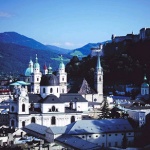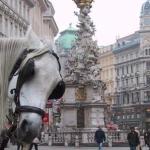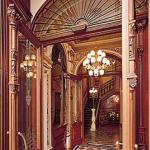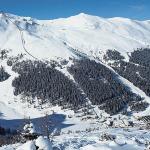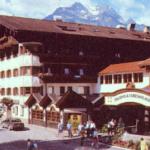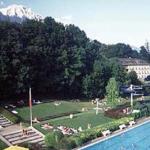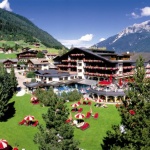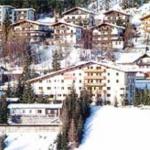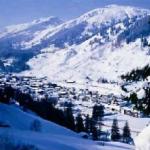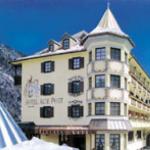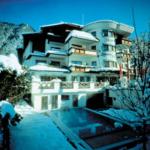Austria Sights
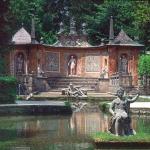 In Austria, considered the most beautiful country in Central Europe, and tourists attracted by beauty of Vienna and the famous ski resorts, as well as the picturesque alpine village of Tyrol, magnificent national parks and the Lake District in the west of the country.
In Austria, considered the most beautiful country in Central Europe, and tourists attracted by beauty of Vienna and the famous ski resorts, as well as the picturesque alpine village of Tyrol, magnificent national parks and the Lake District in the west of the country.Vienna
Vienna, located in a picturesque place in the middle reaches of the Danube and surrounded by the beautiful ridges of the Vienna Woods - one of the most beautiful cities in the world and the "musical capital of Europe. Merging of many cultures over the centuries has created this unique architecture, was damaged during the Second World War, but almost completely restored hardworking crowns.
The symbol of the city - Cathedral of St. Stephen (Shtefansdom), the patron saint of the capital of Austria. Cathedral of more than 800 years. Under the cathedral are the ancient catacombs - the burial place of the representatives of the Habsburg dynasty, its interior is fascinating simply beautiful, but its spire built into the Turkish shot, released to the church during the Turkish siege of the city in the XVI century. On the walls you can see Shtefansdoma measure the length, size and weight, which in the Middle Ages checked when buying goods, but with its observation deck magnificent view of the Danube and Vienna. Instead of the cathedral is a beautiful area Shtefansplatts and post-modern glass building commercial center Haas House. Departs from the square street Graben, "the heart of the city," another symbol of Vienna, where the focus of such famous landmarks as the column Peytzoyle, Hotel Sacher and the church Peterskirhe. Here are the most fashionable shops. It is interesting to see the nearby Mihalerkirhe, San-Marie-am-Geshtade, Frantsiskanerkirhe, neo-Gothic Town Hall (1872-1883 gg.), One of the most beautiful squares in the world - with Iozefplatts located on it and the Palace Chapel Burgtheater (1874-1888 gg.), Building Parliament (1883), before which stands a statue of Pallas Athena and the famous Vienna State Opera (1861-1869 gg.) - the venue of the cult's annual Opera Ball.
Several south-west of Graben and Iozefplatts lies the majestic Hofburg Imperial Palace complex (XIII-XIX cc.) Built on the site of the Bavarian fort (1278), which is a number of government organizations in the country and the OSCE. In the premises of the palace are the Spanish Riding School - the famous winter riding Habsburg (1735), an exhibition of treasures "Shattskammer" (in her collection made in 962, the crown of the Holy Roman Empire and the Austrian imperial crown), a separate room "Burgundian treasure (jewels , ceremonial robes, jewelry and relics of the Order of the Golden Fleece and the Dukes of Burgundy, including "Holy Spear," which was allegedly pierced the crucified Christ), the imperial reception hall and bedroom of the Kaiser Franz Josef.
In a separate building complex located Vienna State Opera, a unique Austrian National Library (XVIII cent.), Which collected more than 2 million books, music, manuscripts and ancient manuscripts, as well as the court church Avgustinkirhe and one of the richest art collections of the world - Gallery Collection (1800).
Near the Hofburg Palace is a unique shop Petit-Pointe, where for centuries made tiny crosses embroidered handbags, brooches and miniature snuff.
Must be worth visiting the Church of St. Ruprecht and the summer residence of the Habsburgs - Schönbrunn Palace, in which more than 1400 rooms and halls. Now here are located Museum of Weapons, a collection of costumes and horse-drawn carriages "Vagenburg", a beautiful park with fountains, an orangery and a zoo. Architectural patterns are located on a hill in the south-eastern part of the city palace of Prince Eugene of Savoy - Belvedere Castle (1714-1723 gg.) From the Austrian Gallery of Art XIX-XX centuries. (the largest collection of Klimt, Schiele and Kokoschka), and rest of the Archduke Ferdinand, the baroque church Karlskirche (1739) and the Stadtpark, the University, the Palace of Count Manfelda Foundation and the Vatican church.
Pride of Vienna - the most beautiful parks, diverse in their appearance and purpose. Prater Park is considered the most "popular" park in Vienna (in force since the XVIII century.) And is famous for the largest Ferris wheel in the world (65 m) and excellent restaurants. In the old park Augarten regularly conducted dozens of musical performances and symphony concerts. The famous park "Vienna Woods", located in the neighborhood of the capital, in the foothills of the Eastern Alps - is a forest area with their own towns and hotels, resorts and thermal springs. Limited to one side the picturesque valley of the Danube and the vineyards, and on the other - the famous kurrortnym area of Baden and Bad Foslau, "Vienna Woods" is a favorite vacation spot of the Viennese and visitors alike.
In the Austrian capital, certainly more interesting museums than any other city in the world.
No tourist can not resist the temptation to visit the famous Viennese cafes and restaurants, is as an inherent part of the city, as Shtefansdom or "house curve" Hundertwasser House. Vienna Cafe - the oldest in the world. Best known classic "Maria Theresia" fashionable "Before-end-Co" modernist "Museum" and "Mozart", "cab", "Central", "Melange" and "Demel", where going to the most motley crowd, Freud's favorite cafe - "Landman," respectable "Zahir" and "Havelka, whose walls are decorated with paintings left as payment known artists, as well as" Dommayer "which debuted Strauss.
Restaurants capital of not less famous and charming. Historically Piaristenkeller "has two in-house museums, and offers dishes from recipes in the XVIII. Restaurant Greyhenbeysl "- the oldest" saloon "in Vienna, already in the XVI century, worked as a tavern. It visited nearly all the famous people of the country and the world - from Bechovo and Strauss, to Mark Twain and Chaliapin. The famous restaurant "Plashutta on Auhofshtrasse," Temple "on Pratershtrasse," Hansen "and" Shtomah ", as well as wine cellars (" Heuriger ") district Grintsing. Total in Vienna more than 180 comfortable "Heuriger" - from the tiny, no larger than living room, where regulars come from adjacent streets, to huge, luxuriously furnished rooms, where you can meet and simple wedding, and the aristocrat of the "high society".
Surroundings of Vienna
Surroundings of Vienna no less good than the capital. On the bank of the Danube, 70 km west of Vienna, lie the ruins of the fortress Dyurnshteyn (XII century.), Where a prisoner was the legendary English king Richard the Lionheart. In Tulln, in the castle Attsenburg the entire year are concerts devoted to Schubert (in these places have names of the great composer's uncle, in which he was often). According to the "Nibelungenlied", here occurred the first battle of the legendary Siegfried with King Etzel of the Huns (Attila). Nearby lie the ruins of the fortress Araburg - the last stronghold of the Protestants in Austria. At 25 km south-west of Vienna located Cistercian monastery Heyligenkreytse. In Gumpoldskirhene towering castle of German knights in the parish church of St. Michael and the statue of St. Nepomuk on the picturesque bridge, as well as the famous wine cellars. Very near to the town of Klosterneuburg is Vienna, where local monks produced wine for almost a thousand years, so the local school of winemaking is considered one of the oldest in Europe.
Lower Austria
Baden
At 25 km south of the capital, among the green hills of the Vienna woods, fields and vineyards lies the famous Baden. This resort with healing hot sulfur springs was known in ancient Rome - here in II. Mr. e. camp was located a Roman cohort, here spent the last years of his life Marcus Aurelius. In 1804-1834 gg. the city was the imperial summer residence, here would come to know and the whole of culture and art. Baden healthful water use in our day for bathing, drinking and prevention of rheumatic disease, arthrosis, diseases of the spine and joints, as well as for general rehabilitation and health care procedures. Be sure to visit Terezienbad ( "baths Theresa") and Tereziengarten ( "Theresa's Garden") with lots of exotic plants, which was founded in 1792 in honor of the Empress Maria Theresa.
Parks Baden themselves are separate memorials - in the spa park band plays on a daily basis and are an arbor, a temple of Beethoven's "floral clock and Monuments Strauss and Lanner, and from late June to early September is the operetta festival at the" summer scene ". Doblhofpark known for the castle Schloss Weikersdorf and wonderful rose garden, which annually celebrated "Baden Days roses". Urban parks and gardens on the outskirts of the city gradually merge with the Vienna woods and vineyards of the valley Helental.
In Baden are located in Europe's largest casino in the magnificent Palace of Congresses, the gallery in the house-museum of Beethoven's magnificent villa Menotti, Junger gallery, the museum of Emperor Franz Joseph, a museum of dolls and games, a great race track, a lot of quiet street with houses and villas in the style " Biedermeier ", a large pedestrian area, cozy coffee and Heuriger. Near Baden are the most beautiful church of Klosterneuburg, historical Purkersdorf, as well as many luxurious villas and parks.
St. Polten Federal Province of Lower Austria is in the lower reaches of the Danube in the north-east, on the border with the Czech Republic and Slovakia. The provincial capital - St. Pölten. This is the oldest Austrian city and is the youngest capital city of the federal lands. It is interesting to visit the Town Hall, Museum "Im Hof" on Hessshtrasse, Palace Pottenbrun with a collection of medieval goblets, Shallaburg Palace, the city cultural center in the Festival hall, exhibition hall and a modern tower, the Historical Museum of Lower Austria and the Museum of Modern Art in a baroque palace Karmeliterhof Romano Gothic Cathedral House on the Square Domplatts, Museum of the episcopate Bischofshofen and Abbey Gertsogenburg, Nussdorf and park dinosaurs Traysmauer.
From St. Pölten starts most trips in the area of fine vineyards - Wachau valley, surrounded by dense coniferous forests countless small lakes region Waldviertel or the foot of the picturesque mountain Foralpenland. In Asparn-an-der-Tsaya is prehistoric open-air museum, in Spitz-an-der-Donau - Museum of navigation, and in Waldkirchen an der Thaya, Austria - Museum of dolls.
Castles and palaces
Across the region, scattered medieval castles and palaces. Very interesting Artshtetten Palace (XVI century). With the museum, Franz Ferdinand, the palace church and tomb, and buried where Franz Ferdinand and his wife were killed in Sarajevo in 1914, the most beautiful palaces of Lower Austria are a Baroque Riegersburg (1735) and Renaissance Shallaburg. However, they do not concede an ancient fortress Rappotgenshtayn, one of the mainstays of Freemasonry - a Baroque palace Rosenau, a Renaissance palace Weitra (1606), the former frontier fortress Raabas (XI cent.) Castle of Wiener Neustadt (XIII cent.) With the Chapel of St. George (1460), Renaissance castles and Grayllenshteyn Rezenburg, Orth Castle (XIII century.) in Orth an der Donau with a museum of fishing and local history museum, the summer residence of the Emperor - Laxenburg, and many other magnificent structures.
Monasteries
Beautiful and local monasteries - Benedictine abbey Zaytenshteten (1112, rebuilt in 1719-1947 gg.), A masterpiece of the Austrian Baroque - Melk (976, rebuilt in 1702-1736 gg.), Altenburg (1144) and Gettvayg ( 1083), Augustinian Dyurnshteyn (1410), Herzogenburg (1244) and Klosterneuburg (1114) with a magnificent treasure of art, as well as the Cistercian Abbey of Heiligenkreuz (1133) with a Romanesque church, chapel (1295 g .), and stained glass windows in the XIII.
National Parks
National Park Donau-Auen is the largest nature reserve in Central Europe, and protects more than 5 thousand species of animals and birds, being both an excellent choice. Tayatal National Park is located in the valley of one of the most beautiful rivers in Europe - Taya, which is the most western point, where the forests are typical for many species of Pannonia. Surrounding the river, lined with "beautiful meadows, the beautiful cliffs of Paleozoic rocks and cliffs abound in the mountains, which makes the park a unique appearance.
Styria
Styria - a federal province of Austria, which borders with Slovenia and is known for its great number of medieval castles and the "Land of Lakes" Salzkammergut. Ancient castles and monasteries scattered throughout the area. Here are the biggest in the country Riegersburg baroque castle with a Gothic chapel, a real knight hall and a collection of medieval weapons, Renaissance chateau Herbershtayn (XIII-XVII vv.) With the armory room, and family portraits, the pilgrimage church of Mariazell (1157) with the treasury Chapel with a silver altar (1727) and the miraculous statue of the XIII century, the former Cistercian abbey of the Order in Neuburg an der der Mürz (1350-1612 gg.) Augustinian monastery in Faure (1163), the oldest Austrian monastery of the Order Cistercian in the Rhine (1129) or the unique Benedictine Monastery in Hess (1000), as well as many other historical and architectural monuments.
Graz
The capital of Styria, Graz - one of the oldest outposts of the Austrian Empire at the Turkish border, and one of the most distinctive cities. In the city you can see the Bishop's Palace, the ruins of the destroyed in 1805 by Napoleon Schlossberg castle (XI cent.) With the clock-tower and bell tower Urturm Glokkenturm, the Cathedral of the Teutonic Knights (XIII cent.), The old Town Hall (XVI cent.), The church Domkirhe (XII cent.), Mausoleum of Emperor Ferdinand II (1614), the famous Opera House, which in January is an opera ball opera Redyuit and celebration "Christmas in Styria" (January), the University Museum of Styria (including the Museum of Applied Arts with its rich collection production of tin and iron), the Museum of Criminology, Arsenal (Tsoyghauz ") with the world's largest collection of medieval weapons (more than 30 thousand exhibits), Museum of Aeronautics, Schloss-Egenburg (1625), with an archaeological museum, a gallery, Alta galleries of a large collection of medieval art and palace Herbstein (XVII century.), which now also is an art gallery.
Salzkammergut
The most attractive holiday destination in Styria is a "Country of Lakes" Salzkammergut. Lake Grundlzee (length 6 km, width - about a kilometer) forms together with the lake Altausseer See beautiful alpine landscape, which for decades has attracted the attention of tourists and artists. On Lake Toplittszee with its jagged rocky shores and cliffs of the Dead Gore has long been legends. No less picturesque and charming lake Shtubenbergzee in eastern Styria, and about Peggau are beautiful stalactite caves.
South Carinthia
South Carinthia, which is the beauty of its nature, is often called the "Austrian Riviera" - is an infinite number of mountains and valleys, picturesque lakes about 1270, on the shores of which are scattered small resort towns with world-class hotels, beautiful beaches and a full infrastructure of rest and also known ski centers.
Klagenfurt and the main resorts
The capital of Carinthia, Klagenfurt, founded in 1252 near the picturesque lake Werther See. This is a very beautiful place, famous for its fleet of "Minimundus" - museum of the reduced 25-fold the masterpieces of world architecture, as well as miniature, but fully-functioning railway and the small port with models of ships. The local attractions include the Renaissance Town Hall with heraldic hall, baroque bishop's palace (XVIII century.) Cathedral (XVI cent.) Museum, Carinthia, and reptiles Happe Zoo and Dinosaur Park - one of the richest collections of amphibians in Europe. In the western Bay of Werther See, among the wooded foothills of the Alps, lies Velden - one of the finest lake resorts in the country with the most modern hotels, casinos, beach cafes, shops and excellent cuisine, and beautiful resorts Pertchah the center of water activities, Varmbad-Filiah with its thermal springs and a national park (20 hectares), green and picturesque Krumpendorf Maria Wörth on a small peninsula on the southern shore of the lake. Thermal Complex Bad Blyumau (15 thousand square meters. M of water area) with indoor and outdoor thermal pools (water temperature +36 C) is considered one of the most modern and technically equipped in Europe - you can get almost everything imaginable and unimaginable procedure.
Castles and monasteries
In Carinthia, many medieval castles and monasteries - lock Portia on the River. Drau, Landkron over the lake Osiaher See and home of the Carinthian castle - the castle Hohostervits, as well as the Dominican monastery frieze with a magnificent basilica (1300), Benedictine abbey of Saint-Paul im Lavantal (1091), Ossiach (based at approximately 1028) and Millshtatt (1060-1068 gg.) with the Basilica of (XII century.), Romanesque arcades and excellent museum. In Maria-Saal is museum of wooden architecture in the open air, representing the real peasant houses life-size, as well as architectural features, traditions and lifestyles of the Austrian countryside. In Treffene located Doll Museum Ellie Ryel, which exhibited excellent puppets (over 650), created by the mistress of the museum. In Gmünd - a private museum car "Porsche" - more than 30 models of machines of the famous brands from 50-ies of XX century.
But the real treasure of Carinthia - its nature. Here are the most famous lake country - Werther Zee, Ossiacher See, Milshtater See and Weissensee, as well as small Afrittser See, Faaker See with unique landscape, Feld-Zee, Koychaher Zee, Klopeiner See (the warmest in Austria), Pressegger See and Lengzee, in which water is remarkably clean and, thanks to hot springs and warm. Mount Obir located next to Eisenkappel in south-western Carinthia, is famous for its stalactite caves. In the National Park Nokberg and is located at an altitude of 1300-2440 meters, you can enjoy the majestic mountain landscapes and learn about ancient traditions of Austria. High Tauern National Park, covering an area of 1,187 sq. miles, attracts the beauty of its peaks, glaciers, lakes and waterfalls, alpine flora and fauna, as well as the wonderful mountain village of Heiligenblut (Holy Blood "), transformed into a modern tourist center. Reserve Rozegg protects more than 350 different species of animals and the fragile alpine flora. Nearby there are terrible and gorge Parra, over which to a great height stretched suspension bridges.
Upper Austria
Federal Province of Upper Austria is located in the north, on the border with the Czech Republic and Germany.
Linz
Linz - the main town of the land and a major port on the Danube. Main attractions Linz - Trinity Column (1723), Landhaus (City Hall, XVI cent.), The Cathedral Alter-house (XVII century.), The People's Garden Kefermarkt and lock Weinberg (XV cent.). Like many cities in Austria, Linz is famous for its museums - Museum of Upper Austria, City Museum, New Gallery and the Diocesan Museum.
Castles and monasteries
In Upper Austria, the vast number of historic castles - Walch in Feklamarkt, palaces and Orth Lanshlosse (XVII century). Gmunden, former residence of landfyursta in Wels (VIII cent.), The biggest castle in Upper Austria - Shaunberg, Clam castle with arched Renaissance courtyard and two Gothic chapels, the Renaissance chateau with Graynburg arcade (1621), a hall for celebrations, chapel and a museum of shipping, as well as many other equally remarkable buildings.
The most famous of the provincial monasteries of the country, the Baroque St. Florian (1071), located in the eponymous town on the burial place of St. Florian. Beautiful rooms, collections, the festival of chamber music and theatrical performances in the palace Tillisburg (July), attract thousands of tourists. In the monastery church buried Anton Bruckner, is located near the original museum affairs and a former fireman hunting castle (1729) with a hunting museum in Hohenbrunn. No less interesting monasteries in Mondsee (748 g.) - the oldest monastery of Upper Austria, the Benedictine abbey in Lambahe (1056) with the church, dating back to 1080, the Order of Trappist monastery in Engelstselle (1293), the Abbey of Shlegle (1218) with an underground chapel, and founded in 777, the Benedictine Abbey of Kremsmünster, famous for its Imperial Hall (1694) and the Observatory (1759).
The popular "Lake District" Salzkammergut continues in Upper Austria. Lake Attersee, Irrsee, Traunsee, Kamerze, Hallshtatter See and Mondenzee ideal for water sports and idle recreation. On the shore of the Wolfgangsee lies the beautiful resort of St. Wolfgang with a museum of dolls and majestic villa Vahler, and scattered on the outskirts of many interesting places. In Mondsee - Museum of peasant farming under the open sky "Rauhhaus. In Steyr is certainly worth a visit museums of his famous weapons factories. In Obertraun - stalactite and ice caves. In Natterbahe - the largest amusement park in Austria "Wild West", in Hinterbyuhle - a unique underground lake, and in Ganserndorfe - Safari Park.
Tyrol
Federal Province of Tyrol, bordering with Italy, Switzerland and Germany, often called "the heart of the Alps." There are more than 600 nodes - "trehtysyachnikov" and 5 glaciers. Combined with an excellent environment, it allows the region considered one of the best winter resorts in the world.
Innsbruck
The main city of the Tyrol - Innsbruck. Known to the XIII century. And from the XVI century. was the residence of Emperor Maximilian. This center crafts and watchmaking, as well as one of the legendary mountain resorts in the country. Innsbruck - the legend of winter sports: the city hosted two Winter Olympics (1964 and 1976.). All six zones riding around the city merged into a single "Big Innsbruck ski season ticket" of 52 lifts. There are about 120 km perfectly prepared runs at altitudes from 900 to 3200 m, more than 100 miles of plains trails, snowboard park and a lot of trekking trails on the slopes of surrounding mountains and the city itself - is a network of shops and restaurants, exciting nightlife and casinos.
In addition, in Innsbruck you can see the Hofburg Imperial Palace (XIV-XVIII cc.), The Franciscan church (XVI century.), Arsenal, the Triumphal Arch (1756), courtier Hovkirhe Church (XVI century.) With a bronze headstone Emperor, the castle Fyurstenburg (XV cent.) Column of St. Anne (1703), the city tower, the palace museum Maximilianeum Goldenes Dahl (Golden Roof), Ambras Castle, Ferdinandeum ethnographic museum with a collection of Gothic paintings, the Alpine Zoo in panorama, and Tyrol Museum of Art. In the town of Wattens, near Innsbruck, in an underground cave of the Museum of the Austrian crystal company, Swarovski "- the famous" Swarovski Crystal Worlds. " This is a real labyrinth of seven rooms connected by narrow corridors and staircases. The halls are exhibited the smallest (0.8 mm) and largest (310 thousand carats) crystal crystals of the world, entered the Guinness Book of Records, as well as the famous "clock potekshie" Dali from the crystal, the front door's favorite horse of the Indian maharajah, Mosaic Runner , hall-crystal and lined from artificial crystal wall height of 11 m and weighing 12 tons!
On the road from Innsbruck to Italy is Europabryukke - the highest bridge in Europe (elevation 200 m, length - 800 m), crossing the valley Viptalya. In Stams attractive Renaissance chateau Tratsberg with the Armory and the Order of Cistercian Abbey (1273) with a Romanesque church. In Schwartz - Castle Froyndsberg (XI century., Rebuilt in 1472), Franciscan Monastery (1507) and the ancient silver mine. In Hal - lock Hazegg (XI cent.) And Mint (1477). In Lienz - Castle Brook, bunk with late-Chapel frescoes, the local museum and the ruins of the castle with a chapel beginning of the XIII century. in Heinfels. A beautiful landscape is decorated with numerous beautiful mountain lakes, the largest of which, Achensee, stretched between the mountains and Karvendel Rofan. Suitable for swimming lake Pillersee and Schwarzsee located near Kitzbühel, on the border with Germany, you can swim in the lake Valhzee, and at the foot of the beautiful Alps Dolomitnovyh has the largest in East Tyrol Lake - Tristaher See.
Zaltsburgerland
Salzburg
Federal Province Zaltsburgerland located in the center of the country. Capital - Salzburg, birthplace of the great Mozart, straggling at the very foot of the Alps. Salzburg stunningly picturesque and famous for its rich culture and annual music festivals. The symbols of the city considered the fortress Hohensalzburg (1077-1861 gg.) With the authority "Salzburg Bull" (XVI cent.), Who served as the residence of the princes, archbishops (1595-1619 gg.) And gave the name of the city, and surrounded by three squares of Salzburg Cathedral (VIII in., rebuilt in 1611-1628 gg.), Castle Mirabell (1606-1727 gg.), and striking of the church - Collegiate, Trinity, Ursulines, and the oldest in the Austrian monastery of St. Peter (696) - in his catacombs already in 250, Christians prayed. Also interested in small and cozy space with a "toy" houses - Alter Markt and Vaag-Platz, the Museum of baroque (the second largest art collection of the country), Toy Museum, House of Nature, an excellent zoo and a house in the street Getreydegasse, the birthplace of the great Mozart . Since 1920 in the city are famous music festivals that attract music lovers from all over Europe.
8 km from the city palace is located Helbrunn (1615), considered one of the best examples of landscape art world and is not inferior to Versailles or Peterhof, and Tennengebirge, south of Salzburg - a cave Aysrizenvelt ( "the world ice giants"). In Nonberge is the oldest nunnery north of the Alps (715 dates), in Mattzee - Church of the Benedictine abbey (about 770), and in Mihaelboyerne - Order of the Benedictine abbey (817) with the Basilica of the XI century. In Verfene be sure to visit the castle Hohenwerfen (1077) and the ice caves in Seekirchen - Amusement Park "Fantasy", and in Hallein - salt mine and the only museum in Europe, the Celts in the open.
From Salzburg you can easily get to the lake district Flahgau, where lie the beautiful mountain lakes Obertrumer Zee, Mattze, Wallersee, as well as popular Zeller See, Fuschlsee and Wolfgangsee.
Burgenland
Eisenstadt
Mostly Federal Province of Burgenland is located at the east, on the border with Hungary, Slovakia and Slovenia. In Eisenstadt, the capital of Burgenland, interest-Platz square Esterhazy, Esterhazy Palace with four wings Baroque (1663-1672 gg.) Hall of Haydn and special occasions splendid rooms, park at Gaydngasse, House-Museum Haydn, Franciscan Church (1625) with crypt family Esterhazy, Town Hall, Church Kalvarinbergkirhe m Haydn mausoleum next to the church Bergkirchen.
Neusiedler Lake and its surroundings
A special attraction is the only steppe lake in Europe, Neusiedlersee National Park Noyvidlerze-Zevinkel. Surrounded on all sides with thickets of reeds, brackish ponds and marshes are extensive (length - 33,5 km, width - 12 km) but shallow (1.8 m) lake is the perfect place for a large number of rare animals and birds, and also a favorite spot of the Austrians. Its southwestern coast stretches a whole series of old castles and monasteries - a Baroque palace in Halbturn (1711), a former Servite Monastery in Loretto (1651), the ruins of the largest castle in Burgenland Landzo, castle Burg Schlaining (1272 ), a medieval castle (XV-XVII vv.) and the Franciscan Monastery (1648) in Güssing and many others.
Vorarlberg
The westernmost province of Austria, Vorarlberg, bordering Switzerland and Germany. In the provincial capital, Bregenz, situated on the southern shore of Lake Constance, interested in City Hall, Tower St Martinsturm (XVII cent.) With a small museum of weapons, palaces and Thurn and Taxis, the House of Congresses and festivals, museum Foralberger-Landsmuzeum with a collection of paintings by Austrian artists and "safari-zoo" on Mount Pfander (1064 m). On the mountain you can climb through the elevator. It offers magnificent views of the lake and its surroundings.
